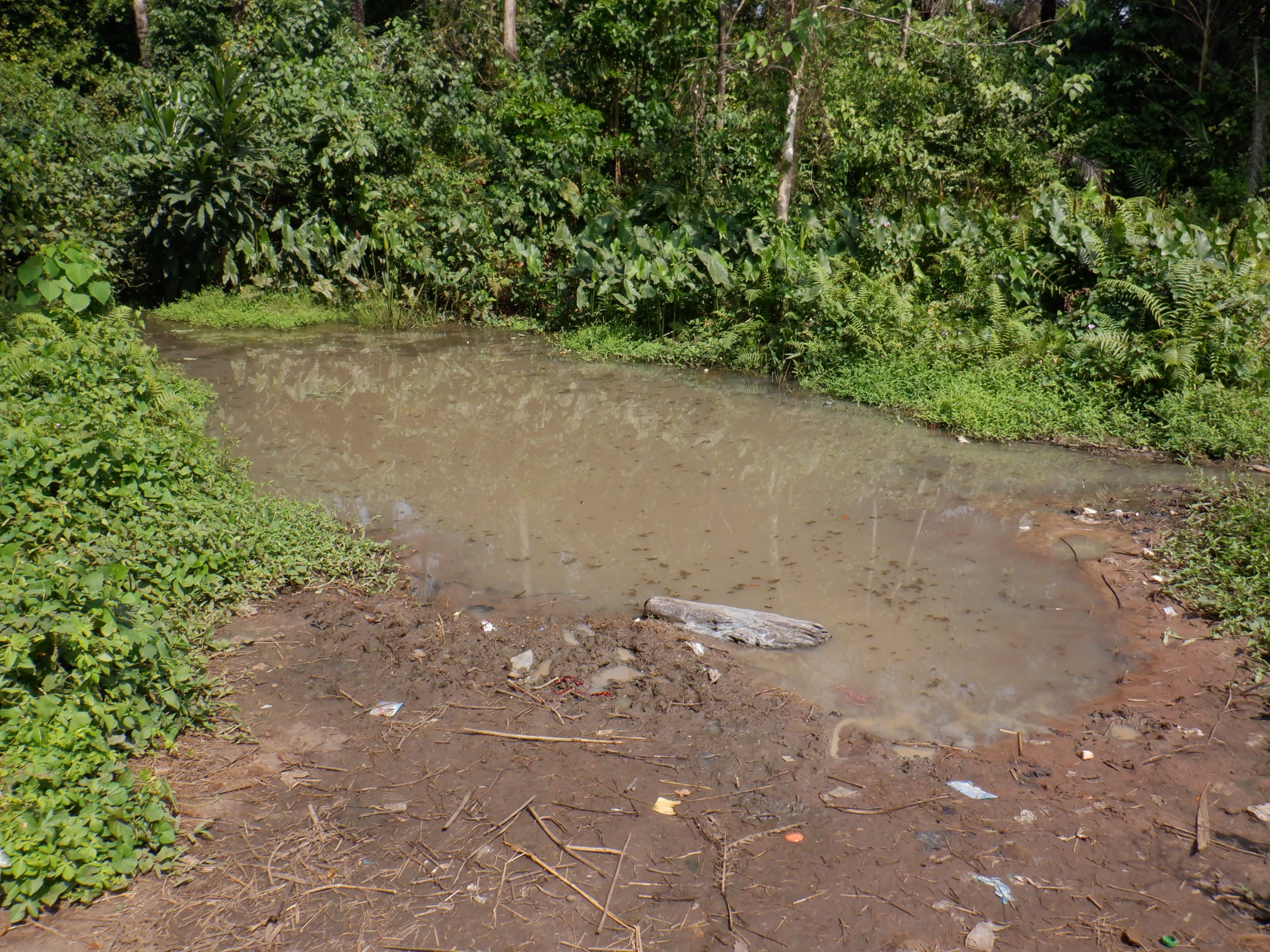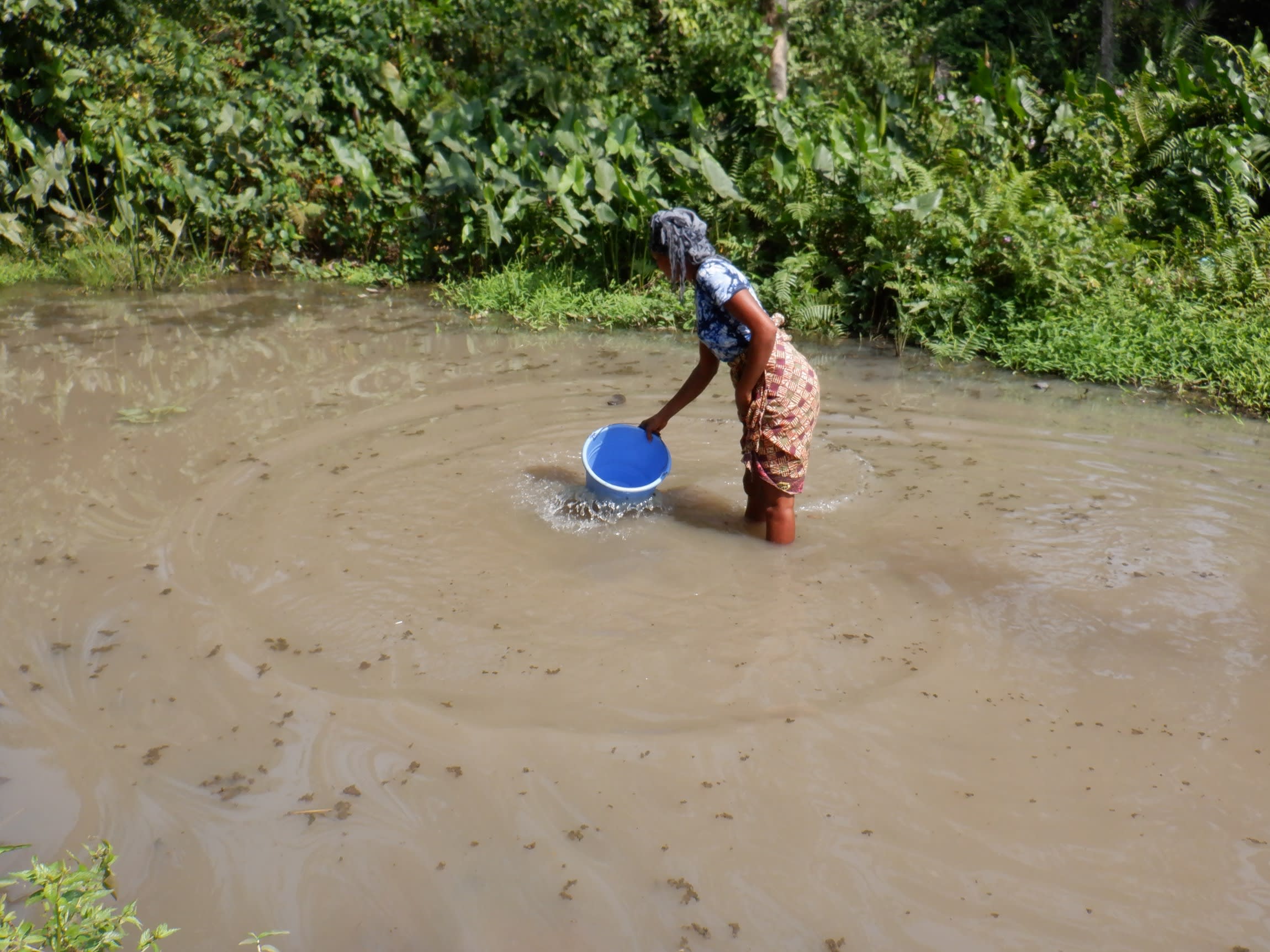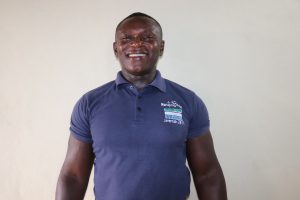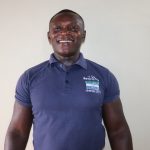Sangoya's main well was built in 1985 and hasn't received any water treatment in two years, allowing worms and cockroaches to breed between the pipes. It also goes dry from February through April. For a village of 444 people, this is unacceptable.
There's a protected well in a neighboring village, but not only is it far away and overcrowded, but it's also experienced seasonal drying. So someone fetching water might trek a very far distance searching first for clean well water, then for questionable well water that's still better than nothing, yet still end up collecting water from their last resort: a murky, polluted stream.

The stream is littered with plastic waste, riddled with soap from the many people that launder and bathe at its edges, and laced with fertilizer from nearby farms. Human activities have altered the color of the water to be milky and opaque.
Unsurprisingly, children in Sangoya must receive regular deworming medication or become seriously ill (which is expensive for a community of farmers and traders). But even without parasites, cholera and typhoid are common here, especially amongst young people.

"Honestly speaking, the water we are using is not good for drinking," said Balu Kanu, a 45-year-old farmer and housewife (in the above photo). "Sometimes, my children and I suffer from a terrible sickness. This situation makes me spend all the money that I receive from the sales of my agricultural products on medicine."
As if all the water quality problems weren't enough, overcrowding is also more than inconvenient for the women and children who do most of the community's water-fetching, like 16-year-old Mabinty (in the photo below at the stream).

"The water situation in my community is not easy for us as students," Mabinty said. "I have to wake up very early in the morning to go in search of water. Usually, the wells will be jampacked with people. I have to wait until the others have completed fetching their water. This makes me not to be punctual in school. I receive punishment almost every day because of my lateness."
Then, after school, Mabinty has to repeat the entire process over again. "After school, I have to fill the remaining drums and go to the farm to join my parents. This action makes me eat late at night and also have limited time to study. I will be exhausted by then, and I have limited time to rest."
When the wells are too full or have dried, Mabinty's only option is the stream. "Fetching water from the stream makes me prone to danger from snakes, and also the boys. Some of them will leave their houses, pretending to draw water from the stream. When they see a girl, they try to have their way, especially when no one is around. Therefore, I will be happy if this community will have a borehole well with a hand pump that will never dry. This will eliminate my constraints in fetching water."
Balu also told us that the stream is dangerous for her children. But if she is to keep her farm afloat, she has no choice but to send them.
"My children face danger when going to the stream, especially in the evening hours," Balu explained. "They are being attacked by snakes. One of my children, Abu, was bitten by a snake on his way from the stream. I thank God, we used our local herbs to cure him."
It's basically impossible to count the ways in which a reliable source of water will aid the people of Sangoya. But mostly, every moment of their lives will be just a little easier. With clean water and training on hygiene and sanitation, everyone's health will improve.
Here’s what we’re going to do about it:
Well Rehabilitation
The well marked for this overhaul is dry for a few months every year and needs major work to supply adequate, clean water to the community year round. The pump will be removed, and a hand auger will be lowered inside and powered by a drill team. This hand auger will allow the team to drill several meters deeper to hit a sufficient water column that will ensure the well supplies water throughout all seasons.
As the team drills, casing will be installed, transforming the bottom of this hand-dug well into a borehole. PVC piping will connect this lower system directly to the pump, a construction that we know will also improve the quality of water.
Once this plan is implemented, everyone within the community will have access to safe drinking water in both quality and quantity, even through the dry months.
Hygiene and Sanitation Training
There will be hygiene and sanitation training sessions offered for three days in a row.
After our visit, the hygiene and sanitation trainer decided it would be best to teach community members how to build a tippy tap (a hand-washing station built with a jerrycan, string, and sticks). They will use these tippy taps for handwashing demonstrations, and will also teach about other tools like dish racks and the importance of properly penning in animals.
These trainings will also strengthen the water user committee that manages and maintains this well. They enforce proper behavior and report to us whenever they need our help solving a serious problem, like a pump breakdown.

 Borehole Well and Hand Pump
Borehole Well and Hand Pump


































